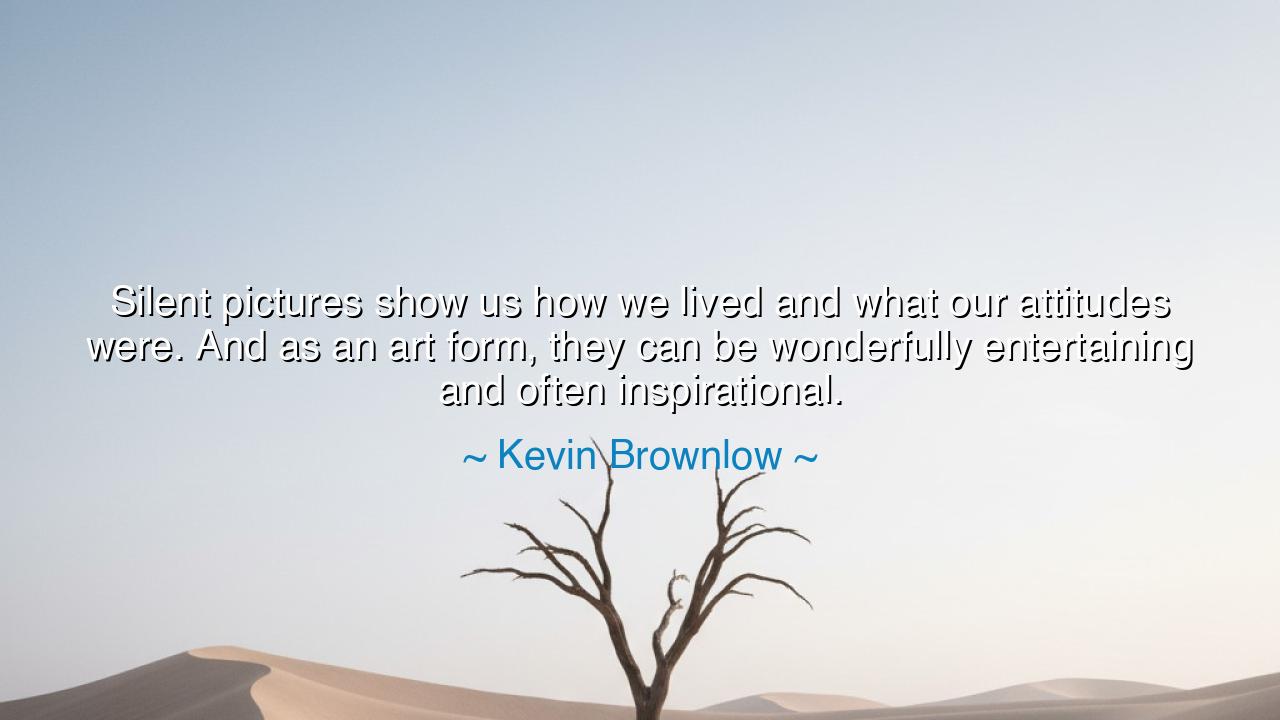
Silent pictures show us how we lived and what our attitudes were.
Silent pictures show us how we lived and what our attitudes were. And as an art form, they can be wonderfully entertaining and often inspirational.






In the grand chronicles of human expression, there are many ways by which we tell the stories of our lives. Some stories are passed down through the spoken word, others through written texts, and yet there is a form of storytelling that transcends language altogether—the silent picture. Kevin Brownlow, a master of preserving the history of cinema, spoke of this powerful art form when he said, "Silent pictures show us how we lived and what our attitudes were. And as an art form, they can be wonderfully entertaining and often inspirational." His words offer a glimpse into the soul of an age now passed, yet whose echoes resonate deeply within our hearts. Silent films, though devoid of sound, are rich with meaning, capturing the essence of humanity through the power of image and the depth of emotion.
In the ancient world, great storytellers would speak of heroes and gods, of battles won and lost, and of lives lived with courage and tragedy. These stories were not just words; they were the expression of an era, a reflection of the people who created them and the lessons they sought to impart. Just as the poets of antiquity used words to capture the essence of their time, so too did early filmmakers use silent pictures to reveal to us who we were and how we lived. These films, though mute, speak volumes about the attitudes, struggles, and triumphs of the people who lived in that age. Silent cinema, then, becomes a mirror, reflecting the inner world of society, allowing us to see, as Brownlow said, how we lived.
Think, dear listener, of the ancient Greeks and their plays—works written by great playwrights like Sophocles and Euripides. These stories were filled with gods and heroes, yet beneath the surface of myth and legend lay a profound understanding of human nature and society. The theatre was not just a form of entertainment, but a lesson in life. It was a space where the people could reflect upon their own existence, their own struggles, and their own aspirations. Silent films, much like the ancient plays, serve a similar purpose—they allow us to see ourselves not only as we are, but as we once were, with all the imperfections and dreams that defined us.
Silent films are not merely relics of a bygone age, but living documents of human experience. In these films, we witness the innocence of early cinema, the simplicity of storytelling, and the raw power of visual expression. In the flickering images on the screen, we can see the hopes, the fears, and the joys of people long gone. The silent era captured a world on the brink of great change, where the language of film was still young and evolving. In the absence of sound, filmmakers relied on the power of the visual image, of gestures and expressions, to convey meaning. And though the films may have lacked the spoken word, they were rich in emotion—sometimes evoking laughter, sometimes tears, but always reminding us of the shared human experience.
One such silent film that endures in the annals of cinematic history is “The General” by Buster Keaton, a masterpiece that speaks both to the comedy of life and to the profound moments of courage that can arise in the most unexpected places. In this film, Keaton, with his famous stoic expression and physical mastery, tells a story of a man who faces tremendous odds, all without the need for words. His actions—his determination, his fear, his triumph—speak to us beyond the constraints of language. “The General” is not just a source of entertainment; it is an inspiration, showing that even in the most trying of circumstances, we can find moments of brilliance and victory. This, dear listener, is the power of silent pictures.
The lesson of the silent film is not just that it entertains us, but that it reminds us of something fundamental—we are all part of a greater story, one that spans across time and culture. Silent pictures allow us to connect with those who came before us, to understand their world, their struggles, and their aspirations. These films show us that, despite the passing of time, we are not so different from those who lived in ages past. We laugh, we cry, we struggle, and we triumph. In this way, silent films become a bridge between the past and the present, allowing us to see ourselves in the stories of those who lived long before us.
To future generations, I urge you to look beyond the noise and distractions of the modern world, and to seek the wisdom and beauty found in the silent pictures of the past. Let these films inspire you, not only as entertainment, but as windows into the human soul. Learn from the gestures, the expressions, the struggles of those who came before you. Let their silent stories remind you that every age, every generation, has its own struggles and triumphs—and that, ultimately, we are all part of the same story. Like the silent films of old, let your actions speak louder than words, and may your life be a source of inspiration for those who follow in your footsteps.






AAdministratorAdministrator
Welcome, honored guests. Please leave a comment, we will respond soon